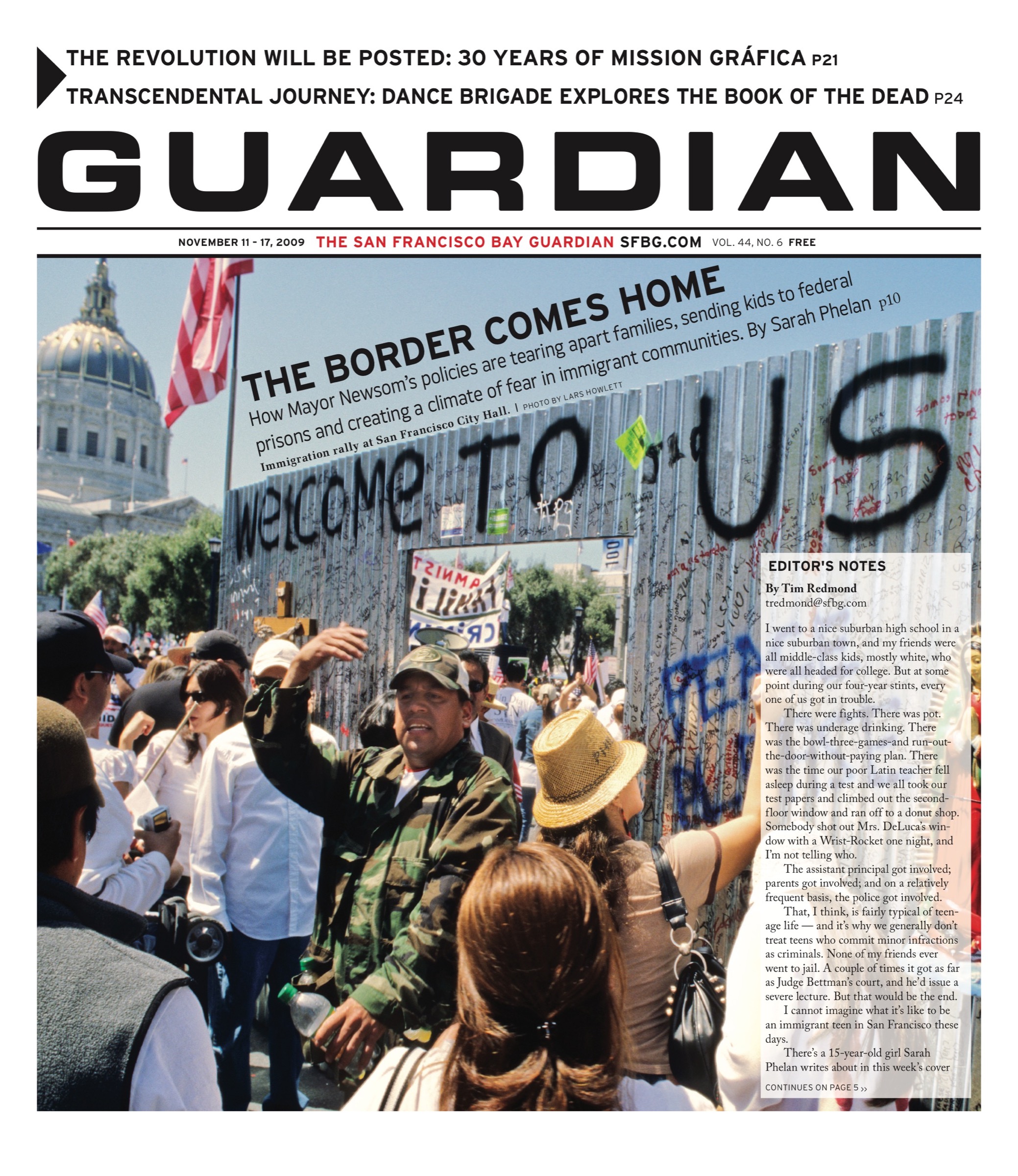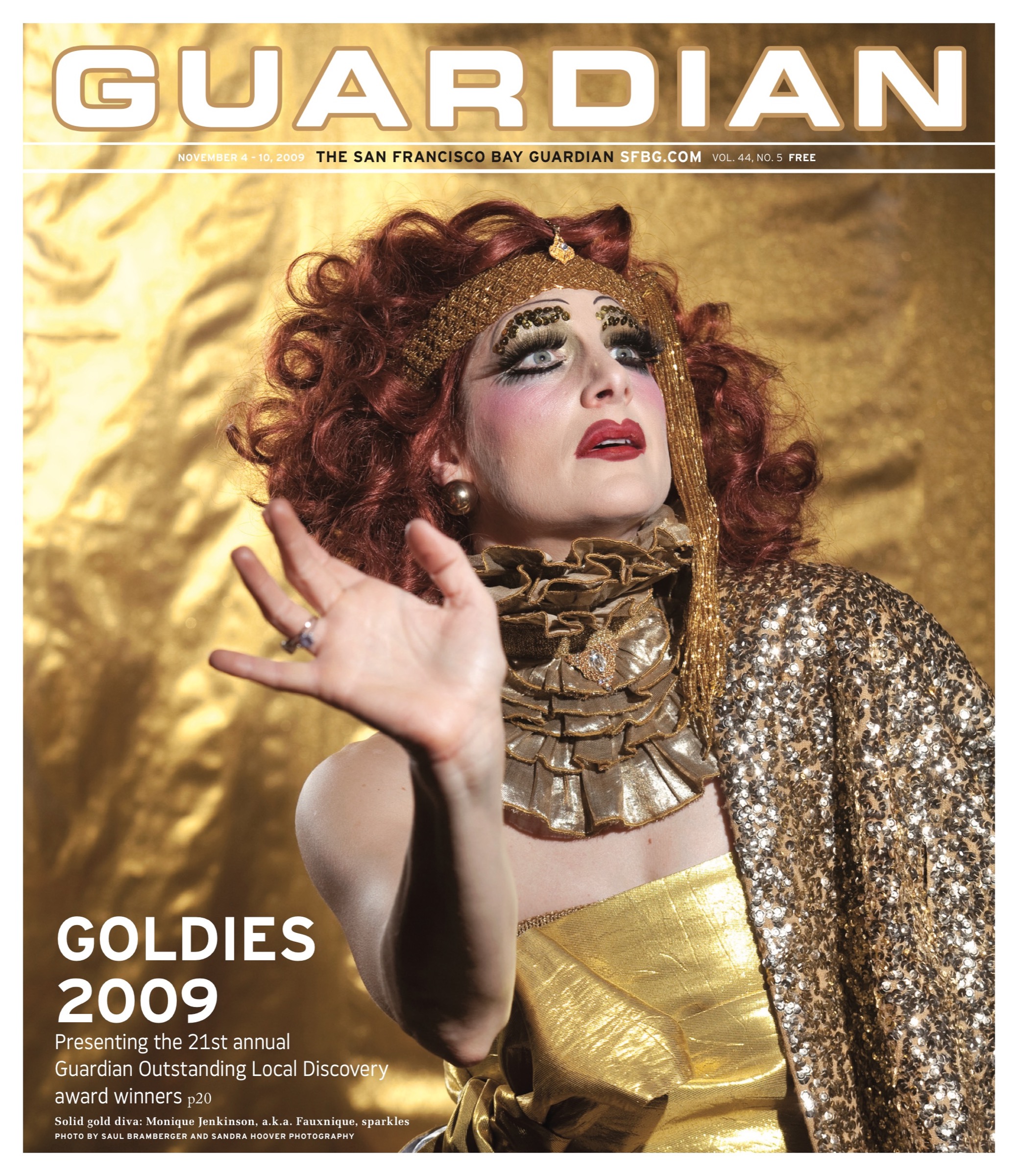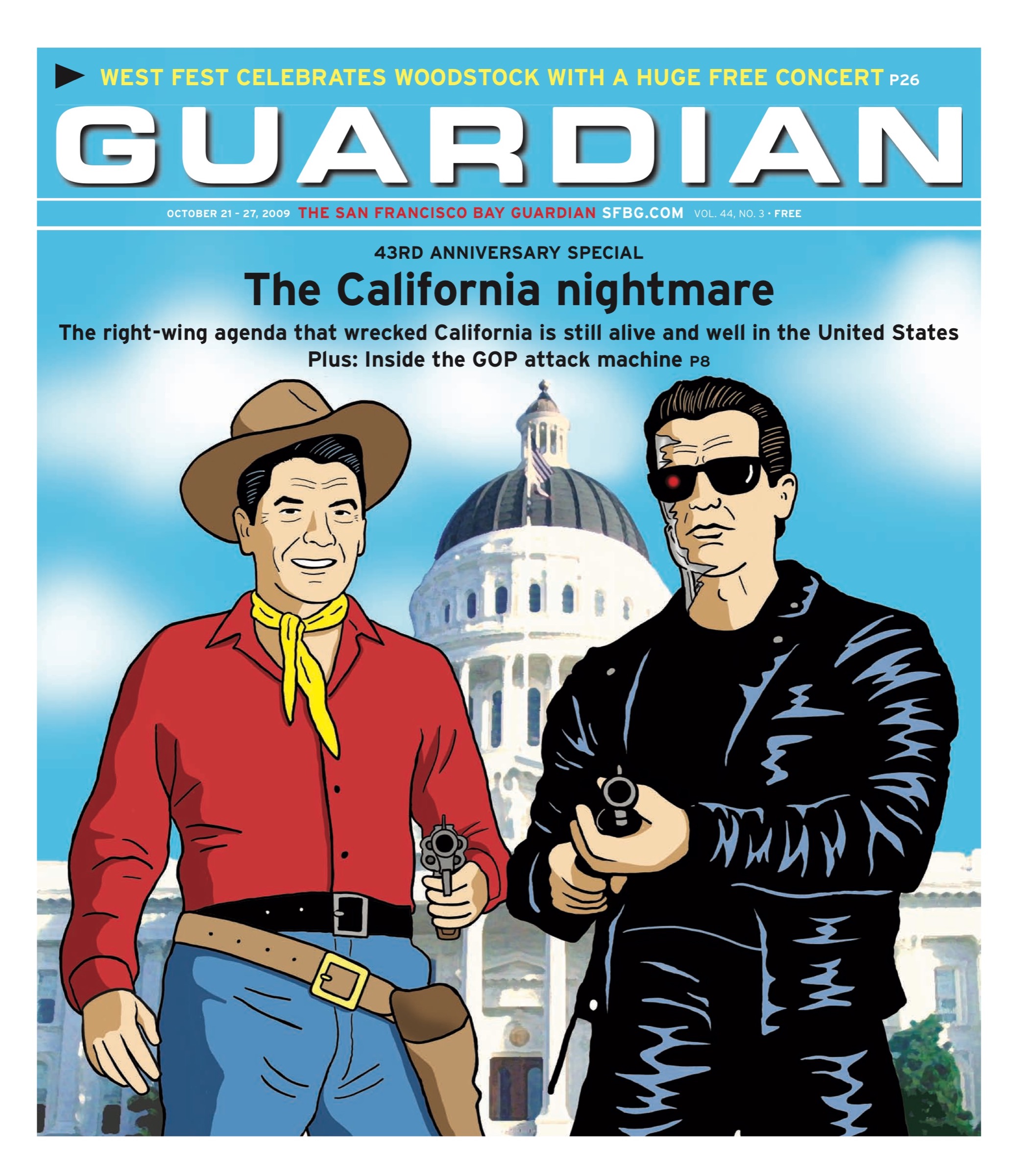Music listings are compiled by Paula Connelly and Cheryl Eddy. Since club life is unpredictable, it’s a good idea to call ahead to confirm bookings and hours. Prices are listed when provided to us. Submit items at listings@sfbg.com.
WEDNESDAY 21
ROCK/BLUES/HIP-HOP
"Annie’s Acoustic Punk Night" Annie’s Social Club. 8pm, $5. With Get Dead!, Officer Down, and special guests.
"Asian Hip-Hop Summit" Elbo Room. 9pm, $5. With Dumbfoundead, Lyraflip, Surilla, DJ Zo, Rising Asterisk, Power Struggle, Mandeep Sethi and MC Humble, and more.
Blind Pilot, Low Anthem, Mimicking Birds Great American Music Hall. 9pm, $16.
Brandi Carlile Fillmore. 8pm, $26.
*Alice Cooper Warfield. 8pm, $35-55.
*Fu Manchu, ASG, It’s Casual Bottom of the Hill. 8:30pm, $15.
Ezra Furman and the Harpoons, BrakesBrakesBrakes, Rachel Goodrich Rickshaw Stop. 8pm, $10.
Honest Thomas, Stomacher, Orchestra of Antlers Kimo’s. 9pm, $4.
Edna Love with the Ed Ivey Band Rasselas Jazz. 8pm, free.
Mindless Things, Shangorillas, Teutonics, Sweet Bones Knockout. 10pm, $5.
Kevin Russell Biscuits and Blues. 8pm, $15.
Ryan Montbleau Band Red Devil Lounge. 8pm, $12.
Spits, Davila 666, Pets, Re-Volts Thee Parkside. 8pm, $10.
Sugarplums, Khi Darag El Rio. 8pm.
USE, Won-Fu, Scrabbel Café du Nord. 8:30pm, $10.
Kurt Vile and the Violators, Wooden Shjips, Young Prisms Hemlock Tavern. 9pm, $10.
JAZZ/NEW MUSIC
ACA and Patrick Cress’ Telepathy Climate Theater, 285 Ninth St., SF; (415) 704-3260. 8pm, $7-15.
"B3 Wednesdays" Coda. 9pm, $7. With Adrian Giovenco.
Ben Marcato and the Mondo Combo Top of the Mark. 7:30pm, $10.
"Benny Goodman Centennial Salute" Herbst Theatre, 401 Van Ness, SF; www.sfjazz.org. 7:30pm, $25-65. With Eddie Daniels Quartet and Jim Rothermel Swingtet.
Stephen Merriman Simple Pleasures, 3434 Balboa, SF; (415) 387-4022. 8pm, free.
Spanish Harlem Orchestra Yoshi’s San Francisco. 8 and 10pm, $16-24.
Tin Cup Serenade Le Colonial, 20 Cosmo Place, SF; (415) 931-3600. 7pm, free.
"The Ukelele: Reimagined" Davies Symphony Hall, 201 Van Ness, SF; www.sfjazz.org. 7:30pm, $25-65. With Jake Shimabukuro.
Willy Billy Rite Spot, 2099 Folsom, SF; (415) 552-6066. 9pm.
FOLK/WORLD/COUNTRY
Ben Brown Plough and Stars. 9pm, free.
BrownChicken BrownCow String Band Hotel Utah. 9pm, $6.
DANCE CLUBS
Booty Call Q-Bar, 456 Castro; www.bootycallwednesdays.com. 9pm. Juanita Moore hosts this dance party, featuring DJ Robot Hustle.
Hands Down! Bar on Church. 9pm, free. With DJs Claksaarb, Mykill, and guests spinning indie, electro, house, and bangers.
Jam Wednesday Infusion Lounge. 10pm, free. DJ Slick Dee.
Qoöl 111 Minna Gallery. 5-10pm, $5. Pan-techno lounge with DJs Spesh, Gil, Hyper D, and Jondi.
RedWine Social Dalva. 9pm-2am, free. DJ TophOne and guests spin outernational funk and get drunk.
Respect Wednesdays End Up. 10pm, $5. Rotating DJs Daddy Rolo, Young Fyah, Irie Dole, I-Vier, Sake One, Serg, and more spinning reggae, dancehall, roots, lovers rock, and mash ups.
Synchronize Il Pirata, 2007 16th St.; (415) 626-2626. 10pm, free. Psychedelic dance music with DJs Helios, Gatto Matto, Psy Lotus, Intergalactoid, and guests.
THURSDAY 22
ROCK/BLUES/HIP-HOP
Back40 Simple Pleasures, 3434 Balboa, SF; (415) 387-4022. 8pm, free.
*"Budget Rock 8 Kick-Off" Eagle Tavern. 9pm, $6. With MC Brontez, Cheap Time, Hunx and His Punx, Primitivas, and Young Offenders. Part of Budget Rock 8.
Phil Crumar and the Wonderfuls Make-Out Room. 8pm, $8.
Chris DeJohn and Neutral Ground Boom Boom Room. 9:30pm, $6.
Don’ts, Finn Riggins, Total Hound Hemlock Tavern. 9pm, $6.
Emmitt-Nershi Band, Assembly of Dust Independent. 8pm, $17.
Heart Warfield. 8pm, $62.50-85.
High Like Five, David Baron, Look the Moon, Mongols Slim’s. 8pm, $13.
Hit the Lights, There For Tomorrow, Fireworks, Sparks the Rescue, This Time Next Year Bottom of the Hill. 6:30pm, $12.
Jibbers, Lucabrazzi, Sprains, Karate Chop Annie’s Social Club. 8pm, $6.
Daniel Johnston, Hymns Warfield. 8pm, $25.
Kid Sister Rickshaw Stop. 9pm, $20.
Kommunity FK Amoeba, 1855 Haight, SF; (415) 831-1200. 6pm, free.
Letters, Google Maps, Jen Grady House of Shields. 8pm, $5.
Mammatus, Glitter Wizard, Bare Wires El Rio. 9pm, $6.
Matisyahu, Jillian Ann Fillmore. 9pm, $15.
Moira Scar, DOG, Taraval Technique Luggage Store, 1007 Market, SF; (415) 255-5971. 8pm, $6-10.
Needtobreathe, Serena Ryder, Alternate Routes Café du Nord. 8pm, $15.
Noah and the Whale, Robert Francis Swedish American Hall (upstairs from Café du Nord). 8pm, $16.
Oceanroyal, Northern Son Hotel Utah. 9pm, $6.
Sir Lord Von Raven, Jail Weddings, Sermon, Naysayers Knockout. 9:30pm, $8.
Spits, Davila 666, Modern Action, Meat Sluts Thee Parkside. 9pm, $10.
"Stevie Ray Vaughn Tribute Show with Alan Iglesias" Biscuits and Blues. 8pm, $16.
Tainted Love Red Devil Lounge. 8pm, $15.
BAY AREA
Echo and the Bunnymen, She Wants Revenge Fox Theater. 8pm, $42.50.
JAZZ/NEW MUSIC
Eric Kurtzrock Trio Ana Mandara, Ghirardelli Square, 891 Beach, SF; (415) 771-6800. 7:30pm, free.
Laurent Fourgo Le Colonial, 20 Cosmo Place, SF; (415) 931-3600. 7:30pm, free.
John Kalleen Group Shanghai 1930. 7pm, free.
Liliana Trio Rite Spot, 2099 Folsom, SF; (415) 552-6066. 9pm.
Marlina Teich Trio Brickhouse, 426 Brannan, SF; (415) 820-1595. 7-10pm, free.
Mo’Fone Coda. 9pm, $7.
David Sanborn Yoshi’s San Francisco. 8 and 10pm, $30-35.
Marcos Silva Yoshi’s San Francisco (in the lounge). 6pm, free.
Stompy Jones Top of the Mark. 7:30pm, $10.
FOLK/WORLD/COUNTRY
"Afro-Cuban Keystones" Herbst Theatre, 401 Van Ness, SF; www.sfjazz.org. 7:30pm, $25-65. With Omar Sosa Quartet featuring Tim Eriksen, and John Santos Sextet.
Ceili Chicks Plough and Stars. 9pm, free.
Flamenco Thursdays Peña Pachamama, 1630 Powell, SF; (415) 646-0018. 8pm, 9:30pm; $12.
High Country Atlas Café. 8pm, free.
Honey, Love Dimension, Nectarine Pie, Dos Hermanos, Lotus Moon Amnesia. 9pm, $8.
DANCE CLUBS
Afrolicious Elbo Room. 9:30pm, $5-6. DJs Pleasuremaker, Señor Oz, J Elrod, and B Lee spin Afrobeat, Tropicália, electro, samba, and funk.
Bingotopia Knockout. 7:30-9:30pm, free. Play for drinks, dignity, and dorky prizes with Lady Miss Stacy Pants.
Caribbean Connection Little Baobab, 3388 19th St; 643-3558. 10pm, $3. DJ Stevie B and guests spin reggae, soca, zouk, reggaetón, and more.
Drop the Pressure Underground SF. 6-10pm, free. Electro, house, and datafunk highlight this weekly happy hour.
Funky Rewind Skylark. 9pm, free. DJ Kung Fu Chris, MAKossa, and rotating guest DJs spin heavy funk breaks, early hip-hop, boogie, and classic Jamaican riddims.
Gymnasium Matador, 10 6th St., SF; (415) 863-4629. 9pm, free. With DJ Violent Vickie and guests spinning electro, hip hop, and disco.
Heat Icon Ultra Lounge. 10pm, free. Hip-hop, R&B, reggae, and soul.
Higher Learning Poleng Lounge. 9pm, $10. With DJs Gabe Bondoc and Mel.
Kick It Bar on Church. 9pm. Hip-hop with DJ Jorge Terez.
Koko Puffs Koko Cocktails, 1060 Geary; 885-4788. 10pm, free. Dubby roots reggae and Jamaican funk from rotating DJs.
Mestiza Bollywood Café, 3376 19th St., SF; (415) 970-0362. 10pm, free. Showcasing progressive Latin and global beats with DJ Juan Data.
Popscene 330 Rich. 10pm, $10. Rotating DJs spinning indie, Britpop, electro, new wave, and post-punk.
Represent Icon Lounge. 10pm, $5. With Resident DJ Ren the Vinyl Archaeologist and guest.
Toppa Top Thursdays Club Six. 9pm, $5. Jah Warrior, Jah Yzer, I-Vier, and Irie Dole spin the reggae jams for your maximum irie-ness.
FRIDAY 23
ROCK/BLUES/HIP-HOP
Bouncing Souls, Bayside, Broadway Calls Slim’s. 8pm, $21.
Boys Like Girls, Cobra Starship, Maine, A Rocket to the Moon, Versa Emerge Warfield. 6:30pm, $27.
Alma Desnuda, Still Time Red Devil Lounge. 8pm, $15.
Dynamic Coda. 10pm, $10.
"An Evening with Lloyd Cole" Swedish American Hall (upstairs from Café du Nord). 8pm, $20.
Liam Finn and Eliza Jane, Jason Lytle Independent. 9pm, $15.
Girl in a Coma, Black Gold Café du Nord. 9:30pm, $12.
Helios Creed, Chrome, Galaxxy Chamber, Toiling Midgets Great American Music Hall. 9pm, $15.
Islands, Jemina Pearl, Toro Y Moi Bottom of the Hill. 9pm, $14.
*Kowloon Walled City, Madrago, Lucika, Cartographer Annie’s Social Club. 8:30pm, $7.
DJ Lebowitz Madrone Art Bar. 6-9pm, free.
Steve Lucky and the Rhumba Bums Biscuits and Blues. 8pm, $20.
Manicato, Raw Deluxe Boom Boom Room. 9:30pm, $10.
Mi Ami, These Are Powers, Gowns Knockout. 10pm, $5.
*Necessary Evils, Black Time, Golden Boys with Greg Ashley, Wounded Lion Thee Parkside. 7pm, $10. Part of Budget Rock 8; with MC John O’Neil and DJs Mitch and Icki.
Joe Pug, Lauren Shera, Guella Hotel Utahl. 9pm, $10.
Amelia Ray Argus Lounge. 9pm, $5.
Steely Dan Nob Hill Masonic Exhibition Hall, 1111 California, SF; www.livenation.com. 8pm, $69-255. Performing Aja.
"TigerBeat6 Label Night/Dance Party" Elbo Room. 9pm, $7-10. With Kid 606, Pigeonfunk, Ghosts on Tape, Pooterhoots, CLAWS vs. DJ Peeplay, and DJ Oonce Oonce.
Train Fillmore. 9pm.
BAY AREA
Mika, Gary Go Fox Theater. 8pm, $29.50.
JAZZ/NEW MUSIC
Audium 9 1616 Bush, SF; (415) 771-1616. 8:30pm, $15.
Black Market Jazz Orchestra Top of the Mark. 9pm, $10.
"Cultural Encounters: Friday Nights at the deYoung presents Jazz at Intersection" Wilsey Court, de Young Museum, 50 Hagiwara Tea Garden Dr, SF; www.deyoungmuseum.org. 6:30pm, free. With Jon Jang and Unbound Chinatown featuring Ms. Min Xiao Fen.
Larry Dunlap Yoshi’s San Francisco (in the lounge). 6pm, free.
Eric Kurtzrock Trio Ana Mandara, Ghirardelli Square, 891 Beach, SF; (415) 771-6800. 8pm, free.
Lucid Lovers Rex Hotel, 562 Sutter, SF; (415) 433-4434. 6-8pm.
Michael McIntosh Rite Spot, 2099 Folsom, SF; (415) 552-6066. 9pm.
"Music and Magnetism" Palace of Fine Arts Theatre, 3301 Lyon, SF; www.sfjazz.org. 8pm, $30-70. With Melody Gardot.
David Sanborn Yoshi’s San Francisco. 8 and 10pm, $35-40.
Terry Disley Experience Shanghai 1930. 7:30pm, free.
Vince Laetano Trio Vin Club, 515 Broadway, SF; (415) 277-7228. 7pm, free.
FOLK/WORLD/COUNTRY
"Cuban Keyboard Maestro" Herbst Theatre, 401 Van Ness, SF; www.sfjazz.org. 8pm, $30-70. With Gonzalo Rubalcaba Quintet.
Cuban Nights Peña Pachamama, 1630 Powell, SF; (415) 646-0018. 8:30pm, $15. With Fito Reinoso.
Judea Eden Band, Bitter Sweet, Blair Hansen Dolores Park Café. 7:30pm, free.
Rob Reich and Craig Ventresco Amnesia. 7pm, free.
Seconds on End Plough and Stars. 9pm.
Sparlha Swa Red Poppy Art House. 8pm, $12-15.
DANCE CLUBS
Activate! Lookout, 3600 16th St; (415) 431-0306. 9pm, $3. Face your demigods and demons at this Red Bull-fueled party.
Bar on Church 9pm. Rotating DJs Zax, Zhaldee, and Nuxx.
Blow Up Rickshaw Stop. 10pm, $15. With DJs Jeffrey Paradise and Richie Panic spinning dance music.
Exhale, Fridays Project One Gallery, 251 Rhode Island; (415) 465-2129. 5pm, $5. Happy hour with art, fine food, and music with Vin Sol, King Most, DJ Centipede, and Shane King.
Fat Stack Fridays Koko Cocktails, 1060 Geary, SF; (415) 885-4788. 10pm, free. With rotating DJs Romanowski, B-Love, Tomas, Toph One, and Vinnie Esparza.
Gay Asian Paradise Club Eight, 1151 Folsom, SF; www.eightsf.com. 9pm, $8. Featuring two dance floors playing dance and hip hop, smoking patio, and 2 for 1 drinks before 10pm. Gymnasium Stud. 10pm, $5. With DJs Violent Vickie and guests spinning electro, disco, rap, and 90s dance and featuring performers, gymnastics, jump rope, drink specials, and more.
Look Out Weekend Bambuddha Lounge. 4pm, free. Drink specials, food menu and resident DJs White Girl Lust, Swayzee, Philie Ocean, and more.
Lucky Road Amnesia. 9pm, $6-10. Featuring live performances by Sister Kate and DJs spinning Balkan, Bangra, Latin, and more.
M4M Fridays Underground SF. 10pm-2am. Joshua J and Frankie Sharp host this man-tastic party.
Makeout Session Club Six. 9pm, $5. With DJs Noah D, Ultravioetntrldphil, and Tblackheart spinning dubstep.
Punk Rock and Shlock Karaoke Annie’s Social Club. 9pm-2am, $5. Eileen and Jody bring you songs from multiple genres to butcher: punk, new wave, alternative, classic rock, and more.
6 to 9 800 Larkin, 800 Larkin, SF; (415) 567-9326. 6pm, free. DJs David Justin and Dean Manning spinning downtempo, electro breaks, techno, and tech house. Free food by 800 Larkin.
Supperclub anniversary Supperclub. 10pm, $20. With DJs Mark Farina, Honey Digon, Rooz, and more spinning house and techno.
Track Meet Club Six. 9pm, $10. A hip hop producer beat battle with special judges Keeley and Mr. Dibia$e.
Very Best 103 Harriet, 103 Harriet, SF; (415) 431-3609. 10pm, $13. Featuring Radioclit and Esau Mwamwaya.
SATURDAY 24
ROCK/BLUES/HIP-HOP
Bouncing Souls, Bayside, Broadway Calls Slim’s. 8pm, $21.
*"BYOQ: Bring Your Own Queer" Music Concourse Bandshell, Golden Gate Park, SF; www.byoq.org. Noon-5pm, free. With Honey Sound System, Rainbow Death Pony, Excuses for Skipping, Lucky Jesus, performances by La Chica Boom and Diamond Daggers, and more.
*Cannabis Corpse, Ramming Speed, Acaphalix El Rio. 10pm, $7.
Jay Farrar and Benjamin Gibbard, John Roderick Bimbo’s 356 Club. 9pm, $25.
Goodie Mob, Scarface Fillmore. 9pm, $36.
Rachel Grimes and Sarah Cahill Swedish American Hall (upstairs from Café du Nord). 7:30pm, $17.
John Lee Hooker Jr. Biscuits and Blues. 8 and 10pm, $22.
Jeremy Jay, Sea Lions, Black Umbrella Knockout. 9pm, $8.
*Mummies, Brentwoods, Fevers, Donny Denim and the Spaghettoes Bottom of the Hill. 8pm, $5. Part of Budget Rock 8; with MC Mike Lucas and DJ Tina Boom Boom.
*Mummies, Younger Lovers, Harold Ray Live in Concert, Okmoniks, Cormans Thee Parkside. 8pm, $5. Part of Budget Rock 8.
Meshell Ndegeocello, Beatropolis Independent. 9pm, $25.
*No Bunny, Rock n’ Roll Adventure Kids, Personal and the Pizzas, Pizzas, Johnny and the Limelight Thee Parkside. 3pm, $5. Part of Budget Rock 8; with MC Personal Pizza and DJs Big Nate and Ayapapaya, plus a pizza-eating contest.
Rykarda Parasol, Nero Nava, Murder of Lilies Café du Nord. 9pm, $12.
Sounds, Shiny Toy Guns, Semi Precious Weapons, Foxy Shazam Warfield. 9pm, $30.
Steely Dan Nob Hill Masonic Exhibition Hall, 1111 California, SF; www.livenation.com. 8pm, $69-255. Performing The Royal Scam.
Stirling Says, Finest Dearest, System and Station Hemlock Tavern. 9:30pm, $7.
Stymie and the Pimp Jones Luv Orchestra Coda. 10pm, $10.
Three Bad Jacks, Mighty Slim Pickins, Naked and Shameless Annie’s Social Club. 9pm, $8.
JAZZ/NEW MUSIC
Audium 9 1616 Bush, SF; (415) 771-1616. 8:30pm, $15.
"Chief Conguero" Herbst Theatre, 401 Van Ness, SF; www.sfjazz.org. 8pm, $22-70. With Poncho Sanchez.
"Crescent City Classic" San Francisco Conservatory of Music, 50 Oak, SF; www.sfjazz.org. 8pm, $30-50. With Henry Butler.
Eric Kurtzrock Trio Ana Mandara, Ghirardelli Square, 891 Beach, SF; (415) 771-6800. 8pm, free.
Dave Matthews Yoshi’s San Francisco (in the lounge). 6pm, free.
Jack Pollard Shanghai 1930. 7:30pm, free.
David Sanborn Yoshi’s San Francisco. 8 and 10pm, $35-40.
Ricardo Scales Top of the Mark. 9pm, $15.
FOLK/WORLD/COUNTRY
Brent Amaker and the Rodeo Amnesia. 9pm, $7-10.
Carnaval Del Sur Peña Pachamama, 1630 Powell, SF; (415) 646-0018. 8pm, $15. Live Flamenco music and dance.
Gas Men Plough and Stars. 9pm.
Claudia Gomez Red Poppy Art House. 8pm, $10-15.
Toshio Hirano Rite Spot, 2099 Folsom, SF; (415) 552-6066. 9pm.
Orixa, Kapakahi, DJ DeeDot Elbo Room. 10pm, $12.
Prince Diabete and Band Noe Valley Ministry, 1021 Sanchez, SF; (415) 454-5238, www.noevalleymusicseries.com. 8:15pm, $17.
John Rybak Cafe Royale, 800 Post, SF; (415) 441-4099. 8pm, free. With Perry Spinali
DANCE CLUBS
Bar on Church 9pm. Rotating DJs Foxxee, Joseph Lee, Zhaldee, Mark Andrus, and Niuxx.
Barefoot Bhangra Party San Francisco Buddhist Center, 37 Bartlett, SF; (415) 289-2019. 7pm, $10 donation. Featuring beginners dance lessons.
Barracuda 111 Minna. 9pm, $5-10. Eclectic 80s music with Djs Damon, Phillie Ocean, and Mod Dave, plus free 80s hair and make-up by professional stylists.
Big Up Magazine Paradise Lounge. 10pm, $20. With DJs Cyrus, Cluekid, Kutz, and more spinning dubstep to celebrate Big Up’s one year anniversary.
Bonobo Mighty. 10pm, $13.
Dirty 30s Suede, 383 Bay, SF; (510) 692-7069. A birthday celebration for Quincy with DJs Mind Motion, Romero, and Fresh spinning hip hop.
Go Bang! Go Boo! Deco SF, 510 Larkin St; (415) 346-2025. 10pm, $5. A scare-abration featuring Pat Les Stache and Steve Mak spinning 70’s/ 80’s disco with resident DJs Eddy Bauer, Nicky B., Sergio and Stanley.
HYP Club Eight, 1151 Folsom, SF; www.eightsf.com. 10pm, free. Gay and lesbian hip hop party, featuring DJs spinning the newest in the top 40s hip hop and hyphy.
soundscape Vortex Room, 1082 Howard, SF. 10pm, $5. With DJs C3PLOS, Brighton Russ, and Nick Waterhouse spinning soul jazz, boogaloo, hammond grooves, and more.
Spirit Fingers Sessions 330 Ritch. 9pm, free. With DJ Morse Code and live guest performances.
Tocadisco Club Six. 9pm, $10. With DJs David Harness, Dan Suda, Peter Gielow, and more spinning house.
SUNDAY 25
ROCK/BLUES/HIP-HOP
"Brutal Sound Effects Festival #67" Hemlock Tavern. 8pm, $7. With Compression of the Chest Cavity Miracle, Elise Baldwin, Sgt. Cobra Queef, David Kendall, Horseflesh, and VSF.
*"Budget Rock Record Swap and Batter Blaster Breakfast" Thee Parkside. 1pm. $5. With Sector Zero, Box Elders, Impediments, Wild Thing, Slippery Slopes, and Outdoorsmen. Part of Budget Rock 8; also with MC Bruce Belden, the Last Punk on Earth; and DJs Carolyn Keddy and Mike.
Discipline, Farewell Typewriter Café du Nord. 9pm, $12.
Gossip, Men, We Are the World Regency Ballroom. 8pm, $22.
*Gris Gris, Thee Oh Sees, Dan Melchior Und Das Menace, Fresh and Onlys Bottom of the Hill. 9pm, $10. Part of Budget Rock 8; with MC Anthony Bedard and Bob McDonald, and DJs Lil Duce and DJ Cityhobb.
Rakim, Rhymefest Slim’s. 9pm, $27.
Jonah Smith, Jenn Grinels, Christopher Hawley Hotel Utah. 8pm, $10.
Steely Dan Nob Hill Masonic Exhibition Hall, 1111 California, SF; www.livenation.com. 7:30pm, $69-255. Performing internet requests.
"West Fest" Speedway Meadow, Golden Gate Park, SF; www.2b1records.com/woodstock40sf. 9am-6pm, free. Celebrate the 40th anniversary of Woodstock with Jefferson Starship, Country Joe McDonald, Leslie West, Jerry Harrison with Ronnie Montrose, and more.
JAZZ/NEW MUSIC
Terry Disley Washington Square Bar and Grill, 1701 Powell, SF; (415) 433-1188. 7pm, free.
Rob Modica and friends Simple Pleasures, 3434 Balboa, SF; (415) 387-4022. 3pm, free.
David Sanborn Yoshi’s San Francisco. 2 and 7pm, $5-35.
Songstresses from the Edge Old First Church, 1751 Sacramento, SF; (415) 474-1608. 4pm, $15.
"A Timeless Hipster" Florence Gould Theatre, Legion of Honor, 34th Ave at Clement, SF; www.sfjazz.org. 2pm, $30-50. With Mark Murphy with Vinny Valentino.
Josh Workman, Noel Jewkes, Michael Zisman Bliss Bar, 4026 24th St, SF; (415) 826-6200. 3pm, $10.
FOLK/WORLD/COUNTRY
Paul Bertolino, Billy and Dolly, Trevor Childs Rite Spot, 2099 Folsom, SF; (415) 552-6066. 9pm.
"Debut from Cuba" San Francisco Conservatory of Music, 50 Oak, SF; www.sfjazz.org. 7pm, $25. With Alfredo Rodriguez.
Quinn DeVeaux and the Blue Beat Review, Bodice Rippers, Emperor Norton’s Jazz Band Amnesia. 9pm, $7-10.
Fiesta Andina! Peña Pachamama, 1630 Powell, SF; (415) 646-0018. 7pm, $10. With Eddy Navia and Sukay.
Mestiza Coda. 8pm.
John Sherry, Kyle Thayer and friends Plough and Stars. 9pm.
"Tropicalismo Titan" Herbst Theatre, 401 Van Ness, SF; www.sfjazz.org. 7pm, $30-70. with Gal Costa.
DANCE CLUBS
DiscoFunk Mashups Cat Club. 10pm, free. House and 70’s music.
Dub Mission Elbo Room. 9pm, $6. Dub, roots, and classic dancehall with DJ Sep, Ludachris, and guest Jon AD.
5 O’Clock Jive Inside Live Art Gallery, 151 Potrero, SF; (415) 305-8242. 5pm, $5. A weekly swing dance party.
45 Club the Funky Side of Soul Knockout. 10pm, free. With dX the Funky Gran Paw, Dirty Dishes, English Steve, and the 14th Floor.
Gloss Sundays Trigger, 2344 Market, SF; (415) 551-CLUB. 7pm. With DJ Hawthorne spinning house, funk, soul, retro, and disco.
Honey Soundsystem Paradise Lounge. 8pm-2am. "Dance floor for dancers – sound system for lovers." Got that?
Jock! Lookout, 3600 16th; 431-0306. 3pm, $2. This high-energy party raises money for LGBT sports teams.
Kick It Bar on Church. 9pm. Hip-hop with DJ Zax.
Last Sunday Bollyhood Café. 5:30pm, $2. With DJs spinning dance hall, soul, and R&B.
Religion Bar on Church. 3pm. With DJ Nikita.
Stag AsiaSF. 6pm, $5. Gay bachelor parties are the target demo of this weekly erotic tea dance.
MONDAY 26
ROCK/BLUES/HIP-HOP
"Growing Pains Tour" Elbo Room. 9pm, $5. With Mestizo, Robust, Digital Digital, Nocando, and Delmon Crew.
Goh Nakamura, Jane Lui, Gabe Bondoc Café du Nord. 8pm, $10.
Sentinel, Malbec, St. Leonards Bottom of the Hill. 9pm, $8.
Sunset Rubdown, tUnE-y ArDs Great American Music Hall. 8pm, $18.
JAZZ/NEW MUSIC
Brubeck Brothers Quartet Yoshi’s San Francisco. 8 and 10pm, $20.
Lavay Smith Trio Enrico’s, 504 Broadway, SF; www.enricossf.com. 7pm, free.
Richard Rite Spot, 2099 Folsom, SF; (415) 552-6066. 9pm.
FOLK/WORLD/COUNTRY
Barefoot Nellies Amnesia. 8:30pm, free.
DANCE CLUBS
Black Gold Koko Cocktails, 1060 Geary; 885-4788. 10pm-2am, free. Senator Soul spins Detroit soul, Motown, New Orleans R&B, and more — all on 45!
Case of the Mondays Triple Crown. 10pm, free. Rotating DJs spinning hip hop, soul, electronic, reggae, and more.
Going Steady Dalva. 10pm, free. DJs Amy and Troy spinning 60’s girl groups, soul, garage, and more.
King of Beats Tunnel Top. 10pm. DJs J-Roca and Kool Karlo spinning reggae, electro, boogie, funk, 90’s hip hop, and more.
Manic Mondays Bar on Church. 9pm. Drink 80-cent cosmos with Djs Mark Andrus and Dangerous Dan.
Monster Show Underground SF. 10pm, $5. Cookie Dough and DJ MC2 make Mondays worth dancing about, with a killer drag show at 11pm.
Network Mondays Azul Lounge, One Tillman Pl; www.inhousetalent.com. 9pm, $5. Hip-hop, R&B, and spoken word open mic, plus featured performers.
Spliff Sessions Tunnel Top. 10pm, free. DJs MAKossa, Kung Fu Chris, and C. Moore spin funk, soul, reggae, hip-hop, and psychedelia on vinyl.
TUESDAY 27
ROCK/BLUES/HIP-HOP
Congress with Valerie Troutt Elbo Room. 9pm, $10.
Alela Diane, Marissa Nadler Rickshaw Stop. 8pm, $12.
"An Evening with Emilie Autumn" Great American Music Hall. 8pm, $16.
Fat Tuesday Band Biscuits and Blues. 8pm, $15.
Fracas, STDs, Kill Crazies, Poison Control Knockout. 10pm, free.
Heavy Slim’s. 8pm, $15.
Kirkwood-Dellinger, 300 Pounds, Dana Alberts Rock-It Room. 9pm.
Lahar Boom Boom Room. 9:30pm, $5.
Le Loup, Nurses, French Miami Bottom of the Hill. 9pm, $12.
Nico Vega, Scene of Action, Endless Hallway Thee Parkside. 8pm, $8.
*Pelican, Black Cobra, Sweet Cobra Independent. 8pm, $15.
Pictures of Then Kimo’s. 9pm, $5.
Pierre Le Robot, Weatherbox, Little Brazil, Raised by Robots Hemlock Tavern. 9pm, $6.
Eliot Rose, Powerdove El Rio. 8pm, free.
Slow Poisoner Brainwash, 1122 Folsom, SF; www.theslowpoisoner.com. 7:15pm, free.
JAZZ/NEW MUSIC
Michael Chase Rite Spot, 2099 Folsom, SF; (415) 552-6066. 9pm.
Dave Parker Quintet Rasselas Jazz. 8pm.
"Jazz Mafia Tuesdays" Coda. 9pm, $7. With Dublin and the Hip-Hop Medicine Band.
Marcus Roberts Trio Yoshi’s San Francisco. 8 and 10pm, $15-20.
Ricardo Scales Top of the Mark. 6:30pm, $5.
Slow Session Plough and Stars. 9pm. With Vince Keehan and friends.
DANCE CLUBS
Alcoholocaust Presents Argus Lounge. 9pm, free. With DJ What’s His Fuck, DJ Freddy MacNugget, and DJ Animal.
Drunken Monkey Lounge Annie’s Social Club. 9pm, free. Random tunes and random chaos.
Eclectic Company Skylark, 9pm, free. DJs Tones and Jaybee spin old school hip hop, bass, dub, glitch, and electro.
La Escuelita Pisco Lounge, 1817 Market, SF; (415) 874-9951. 7pm, free. DJ Juan Data spinning gay-friendly, Latino sing-alongs but no salsa or reggaeton.
Rock Out Karaoke! Amnesia. 7:30pm. With Glenny Kravitz.
Share the Love Trigger, 2344 Market, SF; (415) 551-CLUB. 5pm, free. With DJ Pam Hubbuck spinning house.
Womanizer Bar on Church. 9pm. With DJ Nuxx.











